Your Future is in Gen Zers’ Hands

Recently, I had one of those friendly discussions that never go anywhere – disagreeing about which set of market research projections is the most correct.
This one was for VR (virtual reality) HMD (head-mounted display) with a gaming industry analyst friend, following the gamers’ nirvana … E3.
Ted was complaining that despite all the noise and bravado, HMD manufacturers were dropping prices and offering “specials,” an obvious knee-jerk reaction that units weren’t flying off the shelves as everyone had projected (and cranked up production for).
I mentioned the discussion to David Brady, CEO of Cream Productions, whose firm has produced a number of VR projects, including stream content for TV networks. I figured a person who develops content people participate in and react to might have more savvy about where things are and where they’re heading.
CreamVR has produced Discovery Channel’s “Fear Thy Neighbor” streamed VR content; “Agnus Die” – a tribute to Hitchcock’s epic shower scene; VR content for Travel Channel’s “Wild Things with Dominic Monaghan;” an Americas Civil War VR segment for AHC; “A World without Canada” for Discovery streaming; and well, a lot of stuff.
A complete aside here … being “in the trenches” with Confederate soldiers isn’t cool.
And neither is North America with half of the area gone. Makes the continent look naked!
David just laughed about the numbers and said there are several things wrong with the projections.
He said they’re:
- developed by “older” millennials
- focused on hardware technology/sales, not market absorption
- based on what expected “target” customers will buy … millennials
- overlooking the fact that people of “a certain age” base purchases to a large extent on past personal experience and peer inputs
“We’re still in 1st generation hardware,” Brady explained. “And we can expect at least two to three more versions in the next few years. But right now, you put on an HMD and immerse yourself in the content and you have to say ‘jeezz, this is fantastic.’”
He also said it’s still a nuisance to put on a hot steamy HMD. In addition, the resolution and latency issues have to be resolved.
“However,” he added, “Seeing the investments firms are making, the experience will improve drastically. The content we and others are developing will help them; and their efforts will help us … it’s synergistic.”
Cream and a number of other VR filmmakers’ work has been well received but his most poignant point was that projections were based on the wrong market segment … millennials.
The follow-on Generation Z will be living in and consuming the VR technology just as millennials are today with their iPhones.
“I’ve got an unfair advantage,” he noted. “I have a built-in research lab when I go home every day because I have several teens/tweens and they have friends who come over to try the new stuff.

“They took to VR immediately, even as our developers/production folks were refining their ideas, for the technology,” he explained. “And surprise, boys are different than girls. In watching the two sexes interact with the technology, I’ve come to the conclusion that in general, girls are more interested in the VR experience than boys.
“It seems almost counter-intuitive and it surprised me,” Brady noted. “Females enjoyed climbing, active games, problem solving, involved stories and from watching both sexes interacting with the immersive content, I’m convinced we need to develop more content, games with them in mind.
“I’m no anthropologist or prognosticator,” he added, “but the younger-generation female is growing up with technology like a part of their daily life and AR/VR could play a huge part in the way they mature and where they take us tomorrow.”
“The millennial parent may pay for the new-generation technology; but it’s the teens/tweens, the Gen Z people, who make it happen,” Brady emphasized.
Well, that’s overly obvious!
Back in Steve Jobs’ early Apple days, the company made a concerted effort to put Macs in schools for little or no cost; and folks thought they were crazy.
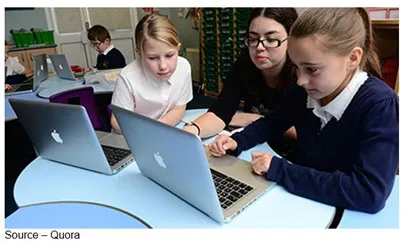
The kids went home and said they’d flunk out and would never amount to anything unless they had a computer like they had at school and BAM!
Others said that was a helluva’ move. This past year, Google jumped in with both feet and the Chromebook has done very well.
And still, when companies want to sell stuff, they focus on millennials because well, they’ve got the money.
But who helps them spend it? Yep – teens/tweens.
Born between 1997 and 2011, the new potential customers are coming of age in large numbers. Marketers can’t afford to take as long to come to grips with them as they did with millennials.
Gen Zers tend to be great multitaskers, lots are self-starters, they’re big on individuality, they tend to have higher expectations than millennials and admit to being more addicted to their digital devices.
According to a recent HuffPost article, a full 40 percent of the younger generation is constantly on their phones or devices.
In the U.S., the 16- to 19-year-olds account for 25.9 percent of the population and contribute about $45B to the economy.
Globally, they are around 2B of the world population–27 percent.
What they’re doing now will impact tomorrow for a long time to come.
While Gen Zers emphasize personal privacy, they expect brands to be fully transparent.
They are frugal and brand-wary but also industrious and collaborative.
Teens/tweens homes have TVs, computers, tablets and smart devices everywhere.
However, their total communications tool of choice is the smartphone. And they’re getting them at a younger and younger age.
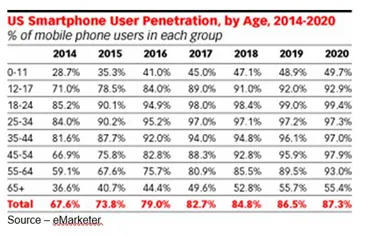
They’re a long way from a toy as well … they use them.
Their smartphone is the primary tool they use for everything.
They expect visual and technical excellence and transparency at their fingertips.
According to Pew Research, more than 24 percent of them are online on their devices constantly. Fifty-six percent are online with their devices several times a day and the dependence (addiction) continues to grow.
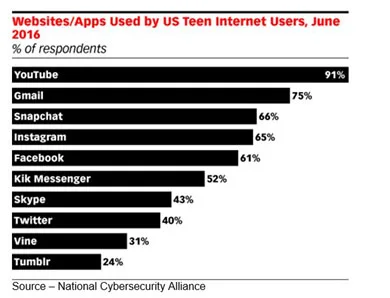
Gen Zers spend more time with video and social media but don’t necessarily cut back on their time with other media.
According to a recent Leflein Associates report, they’re shifting from text-based online content and spending more time with video and social media.
The firm found that teens/tweens are spending more time streaming full-length TV shows and movies and more time with short-form online videos.
The younger audience reported they’re spending less time with blogs and 11 percent are spending less time with publisher sites and apps.
Teens are spending more than one-third of their days using media such as online video or music — nearly nine hours on average.
Common Sense Media found that tweens (8-12) spend an average of six hours a day with their video and music–slightly more than their older siblings.
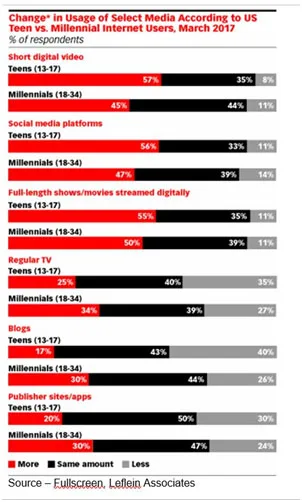
Increasingly, teens view fast Internet access as a human right, along with free content streaming.
A majority of teens (53 percent streaming, 17 percent downloading) in the recent Nielsen report feel long- and short-form video is an important part of their information and entertainment routine. It’s the way they start the day (65 percent before going to school) through to the evening hours (67 percent view before falling asleep).
In other words, video platforms provide the connections they can’t live without.
In the recent Ooyala report, the most widely viewed content was YouTube (85 percent) for short-form content; while Netflix rose in interest to 48 percent for longer-term video to view.

While Gen Zers are more receptive to quality video ads, they react positively to skippable pre-roll ads and are less concerned about non-skippable mid-roll ads.
Four in 10 Gen Z viewers preferred ads to be featured in a video they were watching–as long as it was less than 15 seconds in length.
Smartphone usage finished the quarter with 46.9 percent of all video play, nearly equal to the total of all mobile devices from the previous year.
The trend to interactive video content already caught Netflix’s attention with their first interactive, choose-your-own adventure style show with DreamWorks’ “Puss in Book: Trapped in an Epic Tale.”
The just-released show will only work with limited devices, but the move is an obvious acknowledgement to the “buying influence” of youngsters today.
It will be interesting to see how rapidly they roll the show out across a broad range of devices … especially smartphones.
Putting the young viewer in control of the storyline will be something that Brady and other VR filmmakers watch closely because it has a lot of parallels to the immersive story telling they are working on to deliver.
Millennials and Gen Zers have two distinctly different sets of social media and content viewing habits and millennials (especially marketers) can learn a lot by paying attention to how teens/tweens consume their video content.
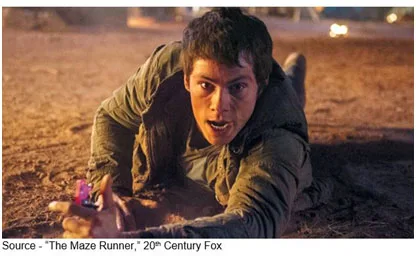 Remember, they were (almost) born with a smartphone in their hands and they probably know how to use it a whole lot better than you or me.
Remember, they were (almost) born with a smartphone in their hands and they probably know how to use it a whole lot better than you or me.
And the generation after them won’t understand how someone could use a communications tool that cumbersome.
As Thomas told the rest of the kids, “We don’t belong here. This place isn’t our home. We were put here. We were trapped here! At least out there, we’ve a choice.”
All the Teds, market forecasters and marketers of the world have to do is watch what they’re doing … and try and keep up.
# # #